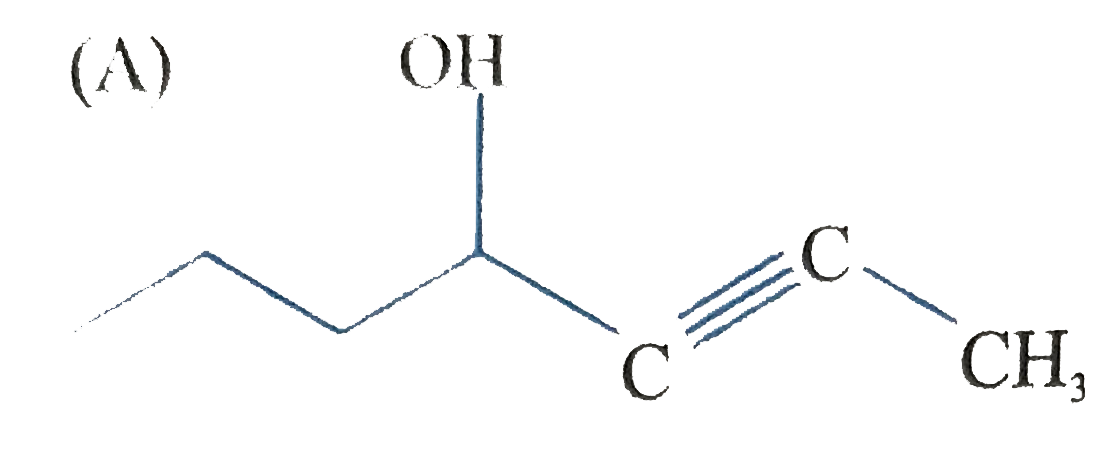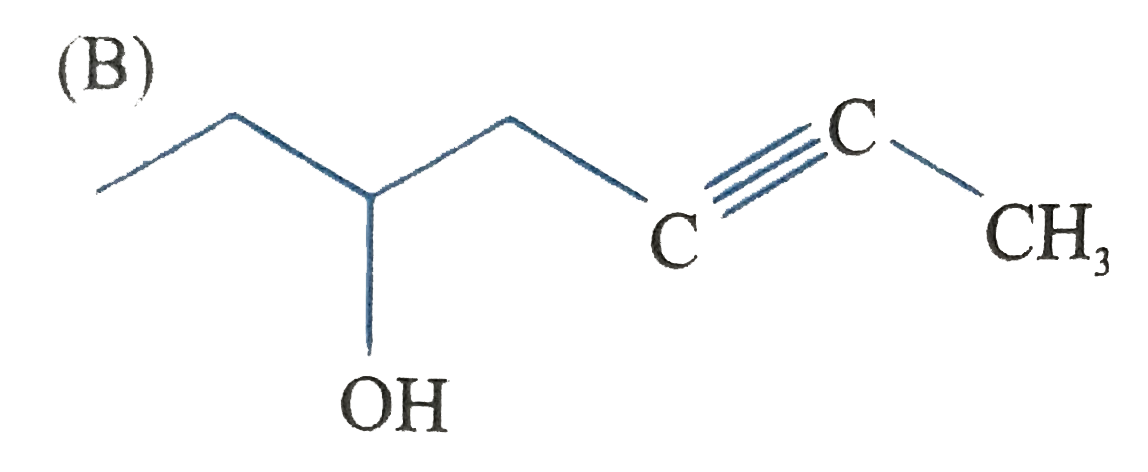Arrange the carbonions,
(CH3)3−C,−CCl3,(CH3)2−CH,C6H5−CH2 in order of their decreasing stability
(CH3)2−CH>−CCl3>C6H5−CH2>(CH3)3−C
−CCl3>C6H5−CH2>(CH3)2−CH>(CH3)3−C
(CH3)3−C>(CH3)2−CH>C6H5−CH2>−CCl3
C6H5−CH2>−CCl3>(CH3)3−C>(CH3)2−CH
The correct Answer is:B
To determine the stability of the given carbanions, we need to analyze the effects of substituents on the carbon atom that carries the negative charge. The stability of carbanions is influenced by inductive effects and resonance.
1. Identify the Structures of the Carbanions:
- (CH₃)₃C⁻: This is a tert-butyl carbanion where the negative charge is on a carbon atom bonded to three methyl groups.
- CCl₃⁻: This is a trichloro carbanion where the negative charge is on a carbon atom bonded to three chlorine atoms.
- (CH₃)₂CH⁻: This is an isopropyl carbanion where the negative charge is on a carbon atom bonded to two methyl groups and one hydrogen.
- C₆H₅CH₂⁻: This is a benzyl carbanion where the negative charge is on a carbon atom bonded to a benzene ring and a hydrogen atom.
2. Analyze the Effects on Stability:
- (CH₃)₃C⁻: The three methyl groups exert a +I (inductive) effect, which increases the electron density at the negatively charged carbon, making it less stable.
- CCl₃⁻: The three chlorine atoms exert a -I (inductive) effect, which decreases the electron density at the negatively charged carbon, making it more stable.
- (CH₃)₂CH⁻: The two methyl groups also exert a +I effect, which increases the electron density at the negatively charged carbon, but less so than in the case of (CH₃)₃C⁻.
- C₆H₅CH₂⁻: The negative charge can be delocalized through resonance with the benzene ring, significantly stabilizing the carbanion.
3. Rank the Carbanions by Stability:
- Most Stable: CCl₃⁻ (due to -I effect from Cl atoms)
- Second Stable: C₆H₅CH₂⁻ (due to resonance stabilization)
- Third Stable: (CH₃)₂CH⁻ (due to +I effect from two methyl groups)
- Least Stable: (CH₃)₃C⁻ (due to +I effect from three methyl groups)
Final Order of Stability:
1. CCl₃⁻
2. C₆H₅CH₂⁻
3. (CH₃)₂CH⁻
4. (CH₃)₃C⁻
- (CH₃)₃C⁻: This is a tert-butyl carbanion where the negative charge is on a carbon atom bonded to three methyl groups.
- CCl₃⁻: This is a trichloro carbanion where the negative charge is on a carbon atom bonded to three chlorine atoms.
- (CH₃)₂CH⁻: This is an isopropyl carbanion where the negative charge is on a carbon atom bonded to two methyl groups and one hydrogen.
- C₆H₅CH₂⁻: This is a benzyl carbanion where the negative charge is on a carbon atom bonded to a benzene ring and a hydrogen atom.
- (CH₃)₃C⁻: The three methyl groups exert a +I (inductive) effect, which increases the electron density at the negatively charged carbon, making it less stable.
- CCl₃⁻: The three chlorine atoms exert a -I (inductive) effect, which decreases the electron density at the negatively charged carbon, making it more stable.
- (CH₃)₂CH⁻: The two methyl groups also exert a +I effect, which increases the electron density at the negatively charged carbon, but less so than in the case of (CH₃)₃C⁻.
- C₆H₅CH₂⁻: The negative charge can be delocalized through resonance with the benzene ring, significantly stabilizing the carbanion.
- Most Stable: CCl₃⁻ (due to -I effect from Cl atoms)
- Second Stable: C₆H₅CH₂⁻ (due to resonance stabilization)
- Third Stable: (CH₃)₂CH⁻ (due to +I effect from two methyl groups)
- Least Stable: (CH₃)₃C⁻ (due to +I effect from three methyl groups)
1. CCl₃⁻
2. C₆H₅CH₂⁻
3. (CH₃)₂CH⁻
4. (CH₃)₃C⁻
Topper's Solved these Questions
- BOOK - MOTIONCHAPTER - GOCEXERCISE - Exercise - 2 (Level - II)114videos
GOC
- BOOK - MOTIONCHAPTER - GOCEXERCISE - Exercise - 344videos
GOC
- BOOK - MOTIONCHAPTER - GOCEXERCISE - Exercise - 130videos
GOC
- BOOK - MOTIONCHAPTER - GASEOUS STATE EXERCISE - EXERCISE-4( LEVEL-II)19videos
GASEOUS STATE
- BOOK - MOTIONCHAPTER - GRIGNARD REAGENTEXERCISE - EXERCISE-216videos
GRIGNARD REAGENT
Similar Questions
(CH3)2Cl∣C−CH2CH3aicXOH−−−−→?
View SolutionArrange the following :
(i) C6H5⋅CHCH3,C6H⋅CHCH=CH2,C6H5CH2⋅CH2,C6H5⋅C(CH3)2
in order of increasing stability.
(ii) CH3CH+2,C6H5CH+2,(CH3)3C+,CH2=CHCH+2
in order of decreasing stability.
(iii) HC≡C−,CH2=CH−,CH3CH−2,CH−3,(CH3)2CH−,C6H5CH−2
in order of increasing stability.View Solution
Knowledge Check
- Question 1 - Select One
Arrange the carbonions,
(CH3)3−C,−CCl3,(CH3)2−CH,C6H5−CH2 in order of their decreasing stabilityAC6H5−CH2>−CCl3>(CH3)3−C>(CH3)2−CHB(CH3)2−CH>−CCl3>C6H5−CH2>(CH3)3−CC−CCl3>C6H5−CH2>(CH3)2−CH>(CH3)3−D(CH3)3−C>(CH3)2−CH>C6H5−CH2>−CCl3 - Question 2 - Select One
CH3CH2CH2−O∣∣C−H+CH3−C≡CHNa,NH3(l)−−−−−−−→
A B
B C
C D
D
- Question 3 - Select One
The IUPAC name of is
C2H5CH2∣∣C−CH2−CH3∣CHNH2A4-Ethylpent-4-en-2-amineB2-Amino-4-ethylpent-4-eneC2-Ethylpentan-4-amineD4-Amino-2-ethylpent-1-ene
The IUPAC name of is
C2H5CH2∣∣C−CH2−CH3∣CHNH2View SolutionThe IUPAC name of C2H5−CH2∣∣C−CH2−CH3∣CHNH2 is:
View SolutionCH3−CH3∣C∣CH3−CH=CH−CH3H−Cl−−−→ ?
View SolutionThe order of decreasing stability of the carbanions
(1) (CH3)3¯¯¯..C (2) (CH3)2¯¯¯..CH
(3) CH3¯¯¯..CH2 (4) C6H5¯¯¯..CH2 isView SolutionIn the compound 1CH2=2CH−3CH2−4CH2−5C≡6CH, the C2−C3 bond is of:
View Solution

